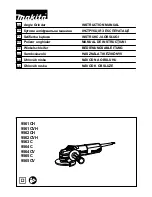
19
bearers are parallel to each other, so posi-
tion them thus. Glue the bearers at both
ends. On the real aircraft the engine bearers
are held to the support beam by U bolts over
the bearers. You can use brass wire to fake
these bolts or omit them. There is also an
angle brace on each side securing the bear-
ers to the side struts. Make these from brass
strip
(Figure 3-12)
.
Notice that the bearers slope downward pro-
viding downthrust for the propeller. Some
Jenny’s
were built with the bearers level and
therefore had no downthrust.
Note:
If you elect to add the tubing, piping,
and linkages for the engine (see Stage 6), you
may want to hold off on rigging the side
truss wires forward of Station 4 to give you
better access to the interior.
8. Installing the Cockpit Floor Board
Supports and Floor Boards
Edge glue three 1/32" basswood strips
together to form the floor boards. Shape
as shown on the plan. The ends of the
transverse support pieces sit on top of the
lower longerons. The floor boards are level
so the transverse supports vary in height.
Figure 3-13
illustrates the floor boards
and supports.
9. Installing the Longitudinal
Side Seat Rails
The longitudinal seat rails, which also serve
as supports for the elevator bar control fit-
ting and aileron control sheaves, are
secured to the inside of the struts in the
cockpit area from Station 4 to 6. Glue these
to the struts. Assure the correct angle.
Between the seat support rail and lower
longeron, install the two vertical supports
on each side
(Figure 3-14)
.
Note:
Two transverse supports for each seat
and a transverse strut between the rails at
Station 5 will be installed when the seats
are installed. At this point, these strips
would hinder installing the flight controls
on the floor boards.
10. Installing Forward and Rear Cock-
pit Instrument Panels, and Shelf
Behind Rear Cockpit
Firewall:
The real
Jenny
has a steel plate
firewall at Station 3. However, I have elimi-
nated the firewall on the model to provide a
better view of the fuel tank and other inter-
nal items. You could add the firewall if
desired, using aluminum sheet or plywood.
Note:
The
Jenny
instrument panels varied
from aircraft to aircraft. For our model I
have selected an arrangement with the most
common gauges and switches.
Forward cockpit instrument panel:
The
instrument panel former (F1) is laser-cut.
Add the map case, which is simply a shallow
box with a folding door fashioned from wood
strip. Fit the britannia castings for the oil
pressure gauge (E1) and the altimeter (E2).
Beforehand, drill a hole in the back of E1
FIG. 3-11 INSTALLING NOSE & NOSE SIDE PLATES
BEND TABS IN ENGINE
BEARER HOLES
DOWN AND AFT TO
SUPPORT BEARER
NOSE PLATE
F14
HOLE FOR R1 – DRILL
THROUGH F15 HOLES
BEND THESE TABS DOWN
AND AFT TO ANGLE
OF LONGERONS
BEND RADIATOR SUPPORT
TABS UP AND FORWARD
R1
FIG. 3-13 INSTALLING FLOOR BOARDS
STATION 5
STRUT
LONGERON
ADD SHIM AS NECESSARY SO TOP
OF STATION STRUT IS LEVEL WITH
OTHER FLOOR BOARD SUPPORTS
STATION 4 STRUT
TYPICAL 1/16"-THICK FLOOR BOARD
SUPPORTS – ALL HAVE DIFFERENT
HEIGHTS SO FLOOR BOARD WILL BE LEVEL
FIG. 3-12 INSTALLING THE ENGINE BEARERS & SUPPORT
F15 SIDE
NOSE PLATE
(BOTH SIDES)
R1
1/8" X 3/16"
ENGINE BEARER
BEARER IS
FLUSH WITH
FRONT OF
NOSE PLATE
SUPPORT TAB IN NOSE
PLATE (SEE FIG. 3-11)
NOSE PLATE
F14
FIT SUPPORT BEAM IN SIDE
STRUTS FLUSH WITH
OUTSIDE OF STATION 3
1/16" X 3/16" BEARER
SUPPORT BEAM
BETWEEN SIDE STRUTS
ANGLE BRACKET
(BRASS STRIP)
U BOLTS
(BRASS WIRE)
R1 FITTING FOR
CENTER WING SECTION
DRAG WIRE
UPPER LONGERON
1/32"-THICK
FLOOR BOARDS
Содержание CURTISS JN-4D JENNY
Страница 39: ...PHOTOS OF MODEL AIRWAYS JENNY 39...
















































